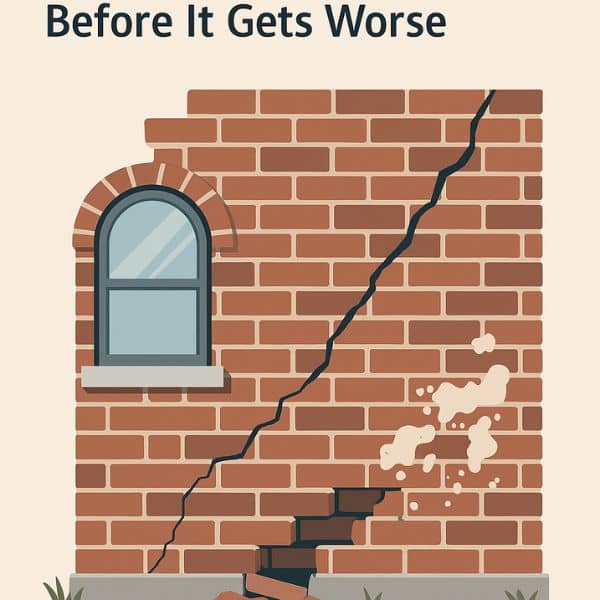
Brick is one of the most durable building materials out there — but it isn’t invincible. Over time, even the strongest brickwork can develop cracks, gaps, or wear that leads to bigger problems down the road. If you catch these issues early, brick masonry repair is usually simple and affordable. But if you ignore them, they can cause structural damage, water leaks, or costly restorations.
Here are 7 warning signs your brickwork may need attention — before things get worse.
1. Cracked Bricks or Mortar Joints
Small cracks in brick or mortar are one of the first things to look for. These may seem harmless, but they can expand over time due to weather, settling, or moisture. Cracked mortar weakens the wall, while cracked bricks may allow water inside the structure.
Tip: Horizontal or stair-step cracks are especially concerning — they often signal foundation movement.
2. Bulging or Bowing Walls
If any part of your brick wall is pushing outward, bowing, or uneven, it could be a sign of shifting behind the wall — such as water damage, poor anchoring, or structural settlement. This can become a serious hazard if left unchecked.
Action: Don’t wait to consult a professional if you notice a bulge. The wall may need reinforcement or rebuilding.
3. Discolored or White Streaks (Efflorescence)
That chalky white powder on your brick surface? It’s called efflorescence, and it’s caused by salt deposits from moisture inside the wall. While it’s not dangerous on its own, it’s a red flag that water is entering your masonry.
Fixing moisture issues now can prevent mold, rot, and deeper structural decay.
4. Gaps Between Bricks and Windows or Doors
As buildings settle or brick expands and contracts, gaps can form around frames. These are not just cosmetic — they can lead to drafts, water leaks, and insect problems.
Quick caulking isn’t enough. Proper brick masonry repair involves addressing the cause, not just the crack.
5. Loose or Missing Mortar
Mortar is the “glue” holding your bricks together. Over time, it can crumble or erode due to weather exposure, especially in older buildings. If you see mortar flaking out or missing altogether, your wall is at risk of shifting or collapse.
Tuckpointing — the process of removing and replacing damaged mortar — is the usual solution.
6. Water Damage or Damp Spots Indoors
Brick walls are porous. If they aren’t properly sealed or maintained, water can find its way inside. Look for signs like bubbling paint, musty smells, or damp patches on interior walls — especially after heavy rain.
Ignoring these signs can lead to rot, mold, or hidden structural damage.
7. Bricks Flaking or Falling Apart (Spalling)
When bricks start chipping, breaking, or flaking at the surface, it’s called spalling. This happens when water gets into the brick and freezes, expanding and damaging the surface. Once spalling starts, it tends to spread unless addressed quickly.
Spalling often means bricks are absorbing too much water — sealing or replacing them may be needed.
Why Early Repair Matters
Brick damage doesn’t usually happen overnight. But once it starts, it tends to get worse over time — especially with weather, moisture, and movement. Regular inspections and brick masonry repair can save you thousands by fixing small problems before they turn into major ones.
FAQs
1. How often should I inspect my brickwork?
At least once a year, or after major weather events. Look for cracks, gaps, or discoloration.
2. Can I fix small cracks myself?
Hairline cracks may be sealed with caulk, but larger damage or structural issues should be evaluated by a pro.
3. What is tuckpointing?
It’s the process of removing old, damaged mortar and replacing it with fresh mortar to strengthen the wall.
4. What causes bricks to flake or break?
Usually water damage, freeze-thaw cycles, or poor-quality bricks.
5. Is efflorescence harmful?
Not directly, but it signals water problems that could cause serious damage if ignored.
🧱 Final Thoughts
Your brick walls do more than just look good — they protect your home. Catching these signs early—and getting a professional brickwork evaluation—can help you avoid costly repairs and keep your structure safe for years to come.